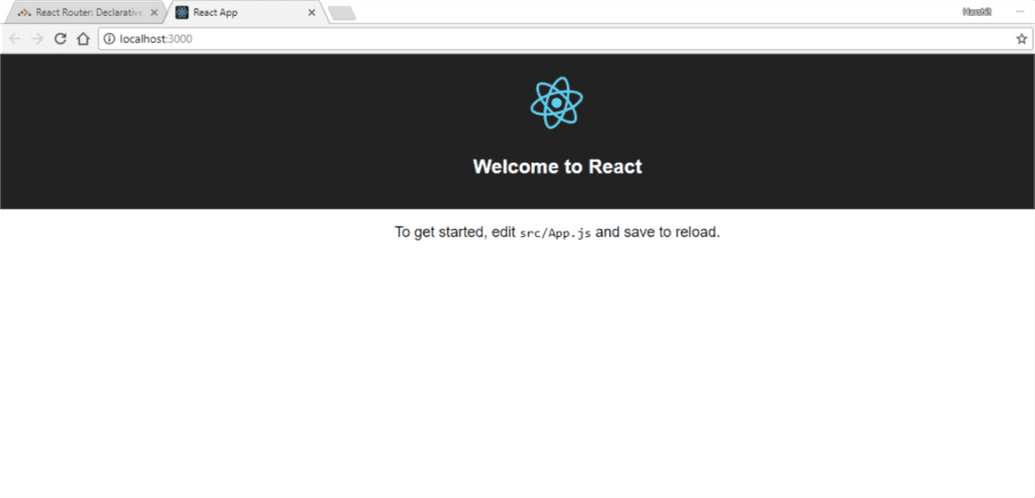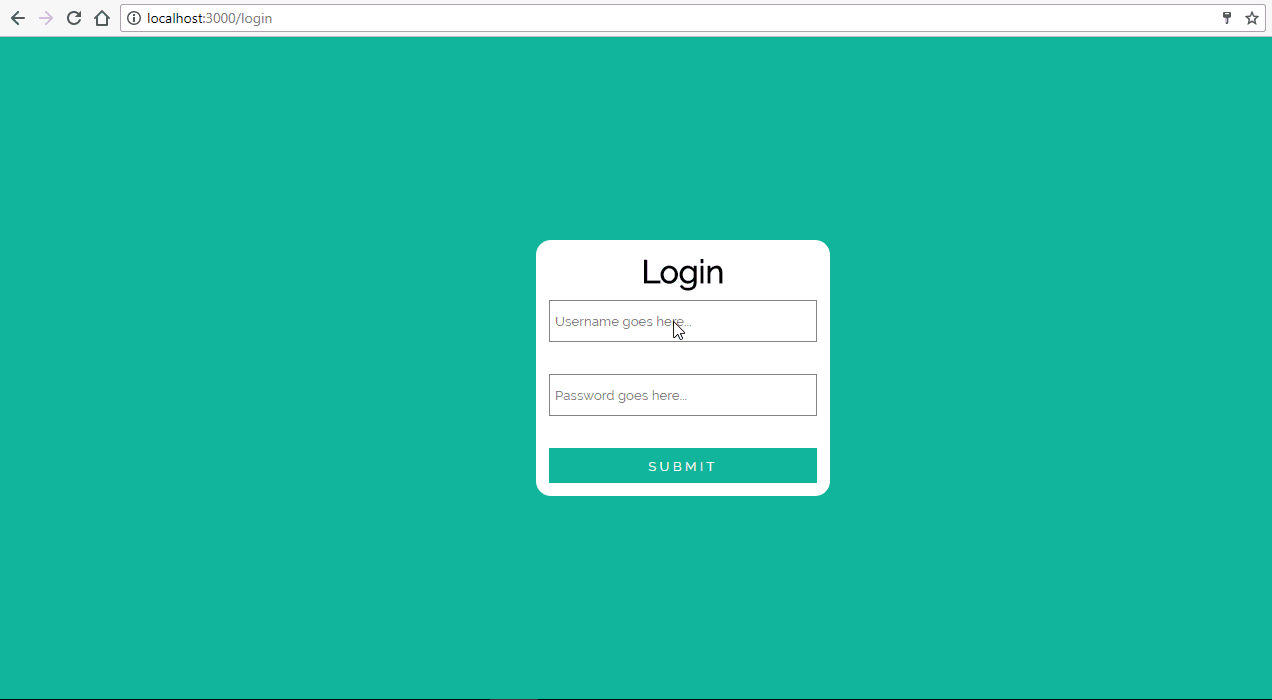JSON Web Token Authentication in React and React-Router
In a previous blog I showed you people how to make a JSON Web Token Authentication Server. You can find that article here. Now in this blog post I am going to show you how you can make use of that JWT auth server in an react application. We will using the concept of higher order component to protect some of our routes. So lets get started.
Prerequesites
- Node.js download it from here
Initialize a React App
We are going to make use of create-react-app tool provided by Facebook to quickly get started with a React App. Install it using npm globally.
> npm install -g create-react-appNow lets Initialize a new React App by using the following command.
> create-react-app jwt-react-authIt will make a folder name jwt-react-auth and give us a very nice development server. Now start the dev server as follows and open the folder in your code editor.
> cd jwt-react-auth
> npm startYour development server should be ready on http://localhost:3000
Get Up and Running With JWT Server
As mentioned earlier the JSON Web Token authentication server we are going to use is from an earlier blog post. You may clone it and set it up by typing the folliwing commands onto your terminal.
> git clone http://github.com/pantharshit00/jwt-auth
> cd jwt-auth
npm install
node app.jsThis should kick off the server on port 8080.
Setting up React Router
Now lets setup react-router. First install using npm.
> npm install react-router-domNow open src/index.js and Bring in react-router’s BrowserRouter and Route as follows.
import { BrowserRouter as Router, Route } from 'react-router-dom';Now change the DOM render as following.
ReactDOM.render(
<Router>
<div>
<Route path="/" component="App" />
</div>
</Router>,
document.getElementById('app')
);You should see the Welcome to React just as before but now it is wrapped inside react router.

Create the login components
Create a components folder in your src folder. Here create two new files Login.js and Login.css .
Add this piece of code to Login.js
import React, { Component } from 'react';
import './Login.css';
class Login extends Component {
constructor() {
super();
this.handleChange = this.handleChange.bind(this);
}
render() {
return (
<div className="center">
<div className="card">
<h1>Login</h1>
<form>
<input
className="form-item"
placeholder="Username goes here..."
name="username"
type="text"
onChange={this.handleChange}
/>
<input
className="form-item"
placeholder="Password goes here..."
name="password"
type="password"
onChange={this.handleChange}
/>
<input className="form-submit" value="SUBMIT" type="submit" />
</form>
</div>
</div>
);
}
handleChange(e) {
this.setState({
[e.target.name]: e.target.value,
});
}
}
export default Login;This is simple react component with some inputs with a handleChange method which sets the input values to state of component.
Add this code to style your Login.css file so that the login page do not look ugly.
@import url('https://fonts.googleapis.com/css?family=Raleway');
.center {
font-family: 'Raleway', sans-serif;
background-color: #1abc9c;
position: absolute;
height: 100%;
width: 100%;
display: flex;
justify-content: center;
align-items: center;
}
.card {
background-color: #fff;
border-radius: 15px;
padding: 0.8rem;
}
.card > form {
display: flex;
flex-direction: column;
}
.card h1 {
text-align: center;
margin-top: 0;
margin-bottom: 10px;
}
.form-item {
font-family: 'Raleway', sans-serif;
padding: 5px;
margin-bottom: 2rem;
height: 30px;
width: 16rem;
border: 1px solid grey;
}
.form-submit {
font-family: 'Raleway', sans-serif;
height: 35px;
color: #fff;
background-color: #1abc9c;
border: none;
letter-spacing: 0.2rem;
transition: 0.3s opacity ease;
cursor: pointer;
}
.form-submit:hover {
opacity: 0.6;
}Now import the login component in src/index file like this
import Login from './components/Login';Add add /login as a route to your router like this.
ReactDOM.render(
<Router>
<div>
<Route exact path="/" component={App} />
<Route exact path="/login" component={Login} />
</div>
</Router>,
document.getElementById('root')
);Now go to http://localhost:3000/login and you should see login page like this.

Create a Authentication Service
Now we will create an Authentication Service class with some useful methods that we can use for authentication.
So create a new file in src/components/AuthService.js and paste the following code.
import decode from 'jwt-decode';
export default class AuthService {
// Initializing important variables
constructor(domain) {
this.domain = domain || 'http://localhost:8080'; // API server domain
this.fetch = this.fetch.bind(this); // React binding stuff
this.login = this.login.bind(this);
this.getProfile = this.getProfile.bind(this);
}
login(username, password) {
// Get a token from api server using the fetch api
return this.fetch(`${this.domain}/login`, {
method: 'POST',
body: JSON.stringify({
username,
password,
}),
}).then(res => {
this.setToken(res.token); // Setting the token in localStorage
return Promise.resolve(res);
});
}
loggedIn() {
// Checks if there is a saved token and it's still valid
const token = this.getToken(); // GEtting token from localstorage
return !!token && !this.isTokenExpired(token); // handwaiving here
}
isTokenExpired(token) {
try {
const decoded = decode(token);
if (decoded.exp < Date.now() / 1000) {
// Checking if token is expired. N
return true;
} else return false;
} catch (err) {
return false;
}
}
setToken(idToken) {
// Saves user token to localStorage
localStorage.setItem('id_token', idToken);
}
getToken() {
// Retrieves the user token from localStorage
return localStorage.getItem('id_token');
}
logout() {
// Clear user token and profile data from localStorage
localStorage.removeItem('id_token');
}
getProfile() {
// Using jwt-decode npm package to decode the token
return decode(this.getToken());
}
fetch(url, options) {
// performs api calls sending the required authentication headers
const headers = {
Accept: 'application/json',
'Content-Type': 'application/json',
};
// Setting Authorization header
// Authorization: Bearer xxxxxxx.xxxxxxxx.xxxxxx
if (this.loggedIn()) {
headers['Authorization'] = 'Bearer ' + this.getToken();
}
return fetch(url, {
headers,
...options,
})
.then(this._checkStatus)
.then(response => response.json());
}
_checkStatus(response) {
// raises an error in case response status is not a success
if (response.status >= 200 && response.status < 300) {
// Success status lies between 200 to 300
return response;
} else {
var error = new Error(response.statusText);
error.response = response;
throw error;
}
}
}This is heavily commented so you will understand what it is doing. It just couple of arbitrary methods like login. We are using the fetch api to perform requests. The token is fetched in the login method and gets stored in the localStorage of the browser. We have also created fetch method which automatically sets the Authorization Header and checks the response status. Now it is time to use these methods.
Using AuthService in Login Page
Import AuthService in Login Page.
import './Login.css';
+ import AuthService from './AuthService';Add AuthService to the contructor.
this.handleChange = this.handleChange.bind(this);
+ this.Auth = new AuthService();Add handleFormSubmit method
handleFormSubmit(e){
e.preventDefault();
this.Auth.login(this.state.username,this.state.password)
.then(res =>{
this.props.history.replace('/');
})
.catch(err =>{
alert(err);
})
}In this method we are calling login method that we created in the Auth service. If we are successfully logged in we are redirect to home page which we will protect with our higher order component later.
Don’t forget to bind handleFormSubmit in contructor
this.handleChange = this.handleChange.bind(this);
+ this.handleFormSubmit = this.handleFormSubmit.bind(this);
this.Auth = new AuthService();Add redirection if we are already loggedIn
We do not want to stay in the login page if we are already loggedIn. So add this componentWillMount method hook to prevent it.
componentWillMount(){
if(this.Auth.loggedIn())
this.props.history.replace('/');
}Creating our Higer Order Component for Authentication Guard
A higher order component is generally a function which takes in a component and return another enhanced component. Head here to learn more about them.
Create a new file in src/components named withAuth.js
Import React and AuthService
import React, { Component } from 'react'; import AuthService from './AuthService';Export a function
withAuthwhich takes a AuthComponent as a parameterexport default function withAuth(AuthComponent) { // Code here now }Instantiate AuthService
export default function withAuth(AuthComponent) { + const Auth = new AuthService('http://localhost:8080'); }Return a class AuthWrapped in which auth is handled
export default function withAuth(AuthComponent) { const Auth = new AuthService('http://localhost:8080'); + return class AuthWrapped extends Component { + // Code here now + } }Add contructor to class and initialize its state with user as null
constructor() { super(); this.state = { user: null } }Add
componentWillMounthook which checks the authcomponentWillMount() { if (!Auth.loggedIn()) { this.props.history.replace('/login') } else { try { const profile = Auth.getProfile() this.setState({ user: profile }) } catch(err){ Auth.logout() this.props.history.replace('/login') } } }In this lifeCycle hook we are first checking if we are loggedIn() which check the token from the localStorage. Then we are decoding the token so that we may set it to our state. If we failed to decode it so we will redirect to login page.
Add render method
render() { if (this.state.user) { return ( <AuthComponent history={this.props.history} user={this.state.user} /> ) } else { return null } }In render methods we are checking of user exists are passing user to the component.
Our withAuth HOC is ready to be used.
Use the HOC to protect our home page
Open
src/App.jsand paste this markup on the render methodreturn ( <div className="App"> <div className="App-header"> <img src={logo} className="App-logo" alt="logo" /> <h2>Welcome {this.props.user.username}</h2> </div> <p className="App-intro"> <button type="button" className="form-submit" onClick={this.handleLogout.bind(this)} > Logout </button> </p> </div> );
This will give you a Logout button and User greeting so that we may test logout and user data.
Import withAuth and AuthService and instantiate the AuthService at the top of the file.
import AuthService from './components/AuthService'; import withAuth from './components/withAuth'; const Auth = new AuthService();Add a
handleLogout()methodhandleLogout(){ Auth.logout() this.props.history.replace('/login'); }This method that we create in the AuthService will clear the token from localStorage.
Wrap the component in withAuth at the export
- export default App; + export default withAuth(App);
Test the App
There are hard coded user in the server
username: test
password: asdf123
username: test2
password: asdf12345